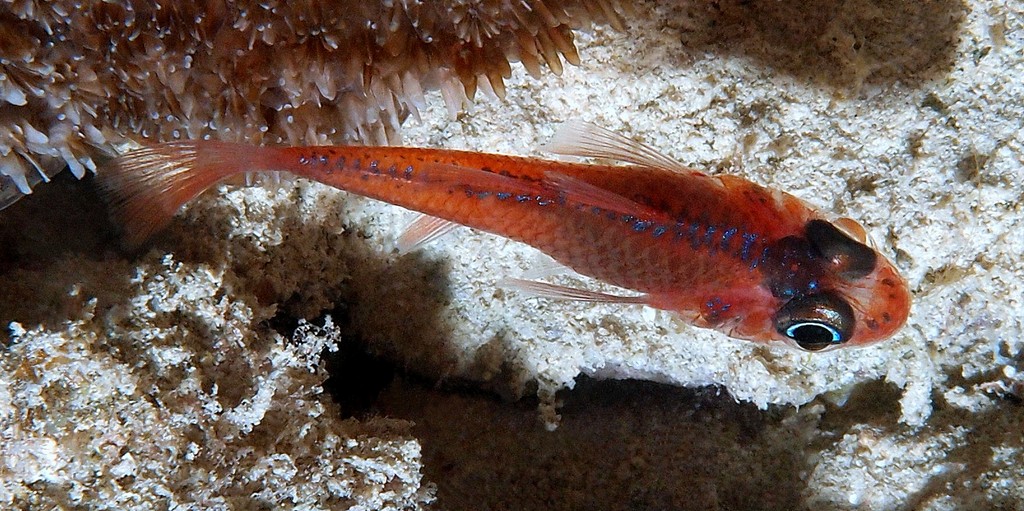APOGON DORYSSA - (JORDAN & SEALE, 1906)
Actinopterygii (Gigaclass) > Actinopteri (Class) > Teleostei (Subclass) > Gobiiformes (Order) > Apogonoidei (Suborder) > Apogonidae (Family) > Apogoninae (Subfamily) > Apogon (Genus)
Poisson cardinal nocturne, Flame cardinalfish, Flathead cardinalfish, Longspine cardinalfish, Night cardinalfish, Sabre-spined cardinal-fish, Yari-ishimochi, ヤリイシモチ, 大目侧仔, 长棘天竺鲷,
Synonymes
Amia doryssa (Jordan & Seale, 1906)
Apogon doryssus (Jordan & Seale, 1906)
Synonymes
Amia doryssa (Jordan & Seale, 1906)
Apogon doryssus (Jordan & Seale, 1906)
-----------------------------
Description
Dorsal spines (total): 7; Dorsal soft rays (total): 9; Anal spines: 2; Anal soft rays: 8; Pectoral fin rays: 11-12 (usually: 12); Lateral line scale: 24-25; Predorsal scales: 5-6; Gill rakers: 4 + 13-15; Body depth: 2.9-3.25 in SL; Caudal peduncle slender, the least depth: 7.6-9.0 in SL; Head length: 2.45-2.6 in SL; Dorsal profil of head nearly straight; Preopercular ridge smooth; Posterior preopercular margin finely serrate; Second dorsal spine very long and strong, about: 1.3 in HL, almost reaching end of second dorsal fin base, when folded down; Caudal fin forked. Max. length: 8.0 cm TL, common length: 4.0 cm SL. Depth range: 4 - 25 m.
Color
Small semi-transparent cardinalfish, with a red head, red concentrated along the vertebral column, the upper and lower edges of the body, and with red scale margins.
Etymology
Apogon: from Greek, a = without + from Greek, pogon = chin, beard.
doryssa: Doris, an Oceanid, was a sea nymph in Greek mythology, whose name represented the bounty of the sea.
Original description: Amia doryssa Jordan & Seale, 1906 - Type locality: Apia, Upolu Island, Samoa.
Distribution
Indo-West Pacific: eastern Mascarenes (Rodrigues), Maldives, Sri Lanka and Christmas Island (Australia), east to Indonesia, Papua New Guinea to Wake Atoll, Marshall Islands and Tuamotu Archipelago (French Polynesia), north to Ryukyu Islands (Japan), south to Queensland (Australia), New Caledonia, Tonga and Rapa (French Polynesia).
Biology
Occurs in sheltered reef flats, lagoons, and seaward reefs. Usually only found at night. Solitary and secretive. Mouthbrooders. Distinct pairing during courtship and spawning.
Similar species
Apogon crassiceps (Garman, 1903) - Reported from New Caledonia.
Description
Dorsal spines (total): 7; Dorsal soft rays (total): 9; Anal spines: 2; Anal soft rays: 8; Pectoral fin rays: 11-12 (usually: 12); Lateral line scale: 24-25; Predorsal scales: 5-6; Gill rakers: 4 + 13-15; Body depth: 2.9-3.25 in SL; Caudal peduncle slender, the least depth: 7.6-9.0 in SL; Head length: 2.45-2.6 in SL; Dorsal profil of head nearly straight; Preopercular ridge smooth; Posterior preopercular margin finely serrate; Second dorsal spine very long and strong, about: 1.3 in HL, almost reaching end of second dorsal fin base, when folded down; Caudal fin forked. Max. length: 8.0 cm TL, common length: 4.0 cm SL. Depth range: 4 - 25 m.
Color
Small semi-transparent cardinalfish, with a red head, red concentrated along the vertebral column, the upper and lower edges of the body, and with red scale margins.
Etymology
Apogon: from Greek, a = without + from Greek, pogon = chin, beard.
doryssa: Doris, an Oceanid, was a sea nymph in Greek mythology, whose name represented the bounty of the sea.
Original description: Amia doryssa Jordan & Seale, 1906 - Type locality: Apia, Upolu Island, Samoa.
Distribution
Indo-West Pacific: eastern Mascarenes (Rodrigues), Maldives, Sri Lanka and Christmas Island (Australia), east to Indonesia, Papua New Guinea to Wake Atoll, Marshall Islands and Tuamotu Archipelago (French Polynesia), north to Ryukyu Islands (Japan), south to Queensland (Australia), New Caledonia, Tonga and Rapa (French Polynesia).
Biology
Occurs in sheltered reef flats, lagoons, and seaward reefs. Usually only found at night. Solitary and secretive. Mouthbrooders. Distinct pairing during courtship and spawning.
Similar species
Apogon crassiceps (Garman, 1903) - Reported from New Caledonia.
Cercamia cladara (Randall & Smith, 1988) - Reported from New Caledonia - Link to the species (here).
Last update: 25, March 2023
